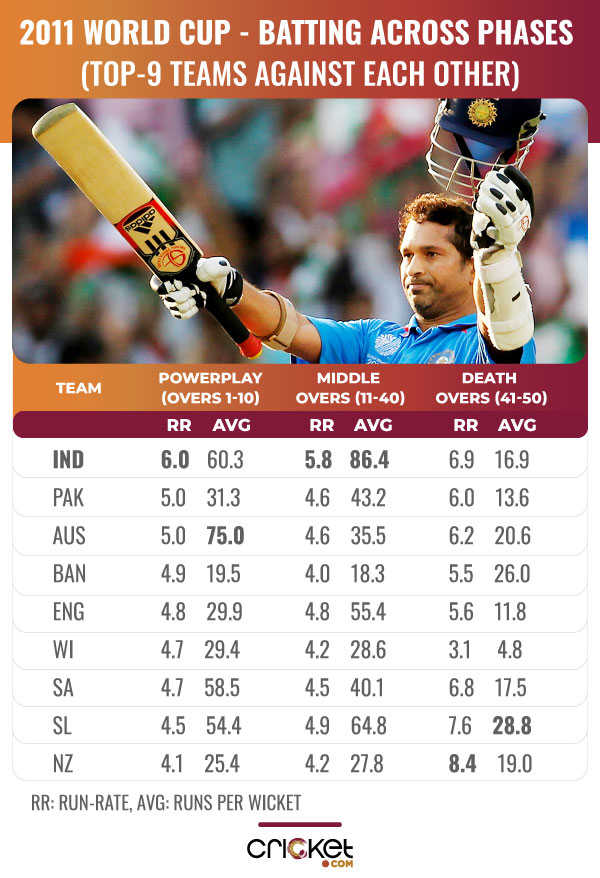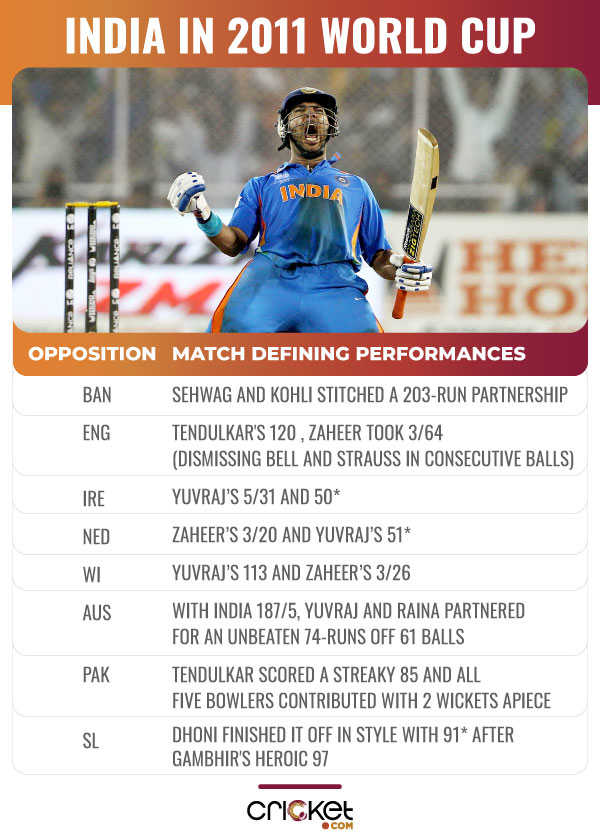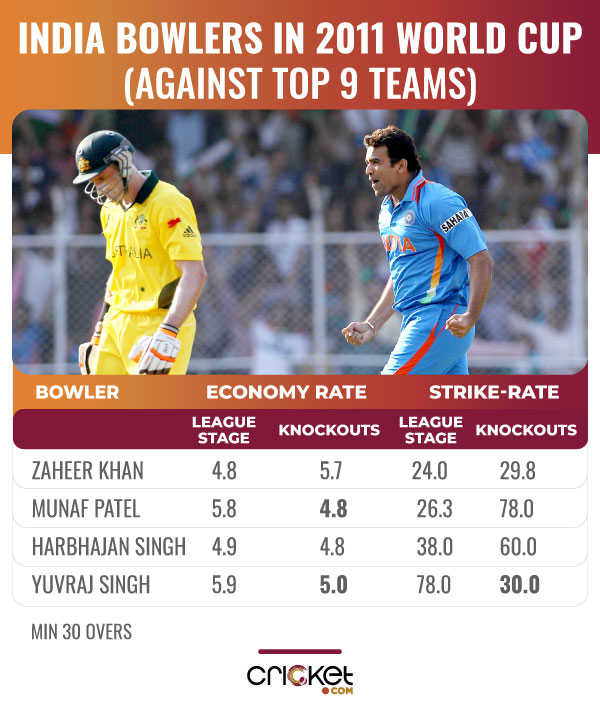 ANALYSIS
ANALYSISFor a nation obsessed with cricket, nothing matters more than the World Cup. In 2011, the thirst for the coveted trophy was at its peak as it had eluded the team for 28 years. Since the heartbreak of 2003 and the disappointment of 2007, the fact that the 2011 edition was to be the last attempt for the country’s demigod in his quest for the trophy only acted as a catalyst for a billion fans.
No team which has staged the mega event before had ever won it till then. However, India had three factors more worrying than this piece of statistical history. Firstly, the team had no proper allrounder in the squad implying that they either had to play five bowlers or rely on part-time options – Yuvraj Singh, Virender Sehwag, Yusuf Pathan and Suresh Raina. Secondly, their number two fast bowler – the injury-prone Munaf Patel – had played only 17 ODIs since 2009. Thirdly, they were unsure of their number seven – Pathan was slightly ahead in contention over Raina after averaging 55.3 in 3 ODIs in the series against South Africa prior to the World Cup.
Overcoming the odds, managing to get the jigsaw together, India ensured that the dream of the nation came alive. The performance was a co-ordinated effort, motivated by the best batsman of his generation, championed by the all-round performance of a passionate cricketer and orchestrated by one of the best white-ball captains the game has ever seen.
Horses for courses
Using their strongest suit to good effect, India were the best batting unit in the tournament. Despite the presence of a great like Tendulkar, India shrugged off their reliance on him as the tournament progressed and emerged as one of the strongest batting units for the nation ever in white-ball cricket.

Sehwag with a strike-rate of 108 in the powerplay (the highest in the tournament) against the Top 9 teams utilized the field restrictions to the fullest. As the tournament progressed, Sehwag getting off the mark with a boundary became his trademark. Out of the eight matches he played, Sehwag hit a four on the very first ball in five matches and in the first over in two others. Tendulkar, behind only to Sehwag with a strike-rate of 98.7 in the first 10 overs delivered a double whammy to the opposition.
Though after a century in the first match against Bangladesh, not many of his innings lasted long, he ensured a brisk start for India, leading the charts with 161 runs in the first ten overs and thus playing his role well.
Tendulkar, on the other hand, hit two hundreds and two fifties against big teams and ended the tournament with the second-highest overall tally of 482 runs.
In the middle overs, India not only had the best run-rate among the top teams but also the best average. Three players – Gautam Gambhir, Tendulkar and Yuvraj were largely responsible for this feat.
Gambhir – 308 runs (average 77, strike-rate 90.6)
Tendulkar- 263 runs (average 52.6, strike-rate 90.4)
Yuvraj- 164 runs (average 164, strike-rate 92.7)
Gambhir, the leading run-scorer in middle overs against top teams, played a lot of crucial innings, none more important than his 97-run knock in the big final. Tendulkar remained the backbone in the middle overs while Yuvraj’s contributions warrant a discussion in greater detail.
Batting in the death overs was a thorn in India’s flesh in the initial phase of the tournament. Against England, India lost their last seven wickets for 33 runs in 24 balls while against South Africa the collapse worsened to six wickets for 13 runs in 35 balls.
The situation improved significantly after India replaced Pathan with Raina. In the knockout matches, India’s batting average in the death overs improved to 42.5 as compared to 12.2 in the league stage with Raina ending the tournament with an average of 60 and a strike-rate of 103.5 in the death overs.
A hero was right round the corner
The path to the title was not as flowery as the batting numbers portray it to be. In almost every big match, India found themselves in an awkward position needing a heroic rescue act. In a side motivated to deliver, quite a few men raised their hands to carry the burden.

Zaheer Khan was the unsung hero for India in the tournament. Ending up as the joint leading wicket-taker of the tournament (21 along with Shahid Afridi), Zaheer was the go-to bowler for MS Dhoni whenever he needed a wicket.
In India’s second game against England, Andrew Strauss and Ian Bell were well set as they brought a mammoth-338 run target down to 59 runs off the last eight overs with eight wickets in hand. Zaheer turned the game on its head by dismissing both off consecutive deliveries in the crucial 43rd over. He cleaned up Paul Collingwood in his next over to put India in the driver’s seat. A game that appeared done and dusted for India ended in a tie only due to the left-armer’s spell.
In the game against Australia, Zaheer accounted for the threatening Michael Hussey and Cameron White in the latter half of the innings and hamstrung the Aussies of any momentum in the death overs.
Back in the 2003 World Cup final, Zaheer started with a 15-run over. Eight years later, a much more experienced cricketer now, Zaheer started with three maiden overs in a row to ensure that Sri Lanka did not get off to a flier.
The 2011 World Cup though belonged to Yuvraj. An elegant left-hander capable of demoralizing any bowling attack with his bat swing and an array of shots contributed with equal impact with the ball in hand. A left-arm orthodox bowler, considered a part-time spinner at best took the mantle of being India’s allrounder and the fifth bowling option. The man of the tournament, Yuvraj won four man of the match awards during the dream run where he scored 303 runs and took 8 wickets against the Top 9 teams.
He delivered his most impactful performance against Australia in the quarter-final, the reigning World Champions from the previous last three editions. As Dhoni cut a ball straight to backward point, India found themselves five down for 187, still needing 75 off 75 balls. Counter-attacking with a glorious 57*, Yuvraj stitched an unbeaten 74-run partnership with Raina, who scored a 28-ball 34 himself to deny the Aussies a place in a World Cup semi-final after 19 years. After hitting the winning boundary, Yuvraj got to his knees and let out a roar that would’ve made the great Muhammad Ali proud.
On the stage of the big final, after Sehwag and Tendulkar failed to get going, it was Gambhir with a gritty 97 and the captain himself, choosing to bat higher up the order despite a quiet tournament till then, hit a flamboyant 91* to get India home. Looking to utilize his ability to pick Muttiah Muralitharan better, something that he learnt after keeping to him in the IPL, Dhoni nullified the Lankan spin threat to ensure a comfortable win for India (in hindsight). It will be criminal to not mention a 35-run knock from a then 22-year Virat Kohli. Walking in the cauldron, after Lasith Malinga chipped-off the openers early, he along with Gambhir absorbed the pressure that made Dhoni's job a little easier.
The weaker suit stepped up
India’s bowling attack was not its strength to begin with. As the tournament progressed this became clear as India failed to defend big totals of 338 and 296 against England and South Africa respectively. The bowling unit was highly unsettled with constant chopping and changing throughout the tournament.
Zaheer was the lynchpin along with Harbhajan who did not take a heap of wickets but managed to keep the opposition quiet. However, they did not find adequate support from the other end in matches against stronger teams in the league stage.
It was in the knockouts when Yuvraj and Munaf stepped up to play a more crucial role.

Yuvraj was not just more economical, he also picked two wickets in each of the knockout matches - the most impactful ones being of a threatening Brad Haddin in the quarter-final, Younis Khan in the semis and Kumar Sangakkara in the final.
Munaf, expensive in the group stage was tighter in the knockouts, controlling one end. Though not picking a lot of wickets, he dismissed Mohammad Hafeez in the semis – the wicket that Tendulkar later termed as the turning point of the match. Harbhajan too timed his wickets well picking Umar Akmal and Afridi at a crucial juncture in the match against Pakistan.
In what was a perfect team effort throughout the tournament, the captain chose the opportune moment to lead by example and finish it off in style allowing the team to envelope in joyous tears. While the players were carrying the man who carried the burden of a nation for 22 years on their shoulders, the cricket-crazy population of more than a billion left all inhibitions behind in a celebration, the emotions of which still sends goosebumps through those who were alive to witness it.